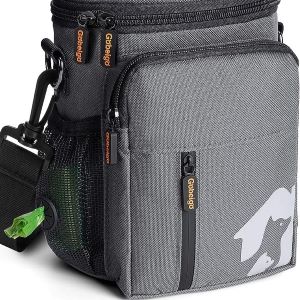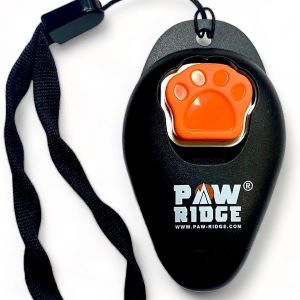Walking a puppy can be challenging, especially if they don’t want to walk. This article will show you how to make your pup walk with some easy and effective methods, and also help you understand why they may refuse to walk in the first place.
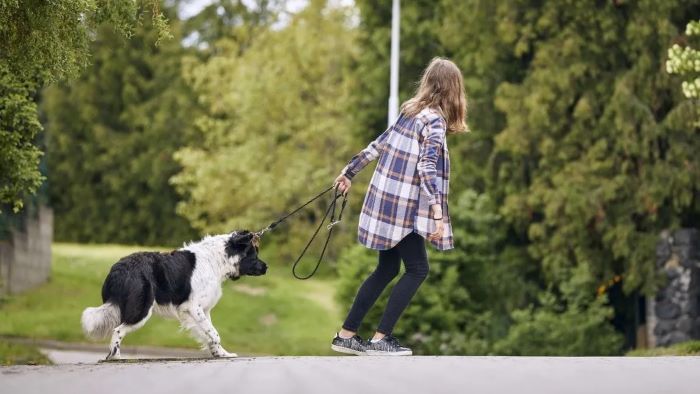
Key Takeaways
- The article provides tips and tricks for making a puppy walk, such as using food treats, toys, clicker, harness, or obedience commands.
- The article also explains some possible reasons why a puppy may refuse to walk, such as health issues, fear, boredom, lack of confidence, stubbornness, separation anxiety, or bad weather.
- The article suggests consulting behaviourists and vets if the puppy still resists walking, and encourages owners to be patient and supportive of their pup.
You Might Also Like:
How To Walk a Puppy That Doesn’t Want to Walk?
For walking a puppy that doesn’t want to walk, you will have to remain calm, patient, and consistent. Calm behaviour, because you may end up scolding your pup if they don’t obey you. Being patient, because training them is challenging, and the consistency prospect refers to maintaining calm and patient behaviour throughout different training methods you plan on using.
Here are some of the methods you can consider for making your puppy walk:
#1 Food treats
Dogs love food and for any given training or activity, you can leverage this prospect to teach them something new or simply get their attention. Here is how you can manage to make your puppy walk:
- Pick a food treat which your puppy loves. Break down their treat into small pieces so they are easy to swallow.
- Use these pieces and place them in different areas in your house. Place it in a way that the last few pieces take them towards the door or your backyard.
- Your puppy will be lured towards the pieces and they will continue to move on the path you set for them. You can also try putting pieces near their nose for them to smell and slowly take them away to initiate their walking movement.
- When they begin to walk, give them the pieces to eat and encourage their behaviour. This helps in registering a positive response in their mind.
Once they begin to respond well to this method, you can change the distance between the pieces every day. This will develop a habit of walking long distances.
#2 Toy
Your puppy surely has a toy which they like the most. You can use their love for such toys and make them walk. Here is how:
- Pick the squeaky toy, the fetch ball, or any other toy which your pup adores. Make sure the toy size is not too small or big for their mouth. Also, see to it that the toys you use are not sharp.
- Similar to the food treat method, you can try placing different toys but, in the backyard or a place where they feel comfortable. Spread out their toys and they might walk or even run across them to play with them.
- You can also try using the luring tactic. Simply hold their favourite toy and use commands such as “good puppy”, “come here”, or “let’s play”, to make them walk with you.
- Repeat this routine and gradually increase the distance. Make them walk longer before they have their toys with them.
When your pup begins to walk for longer distances, continue their routine. Encourage their behaviour and provide them with rewards or food treats to continue showing such positive behaviour.
#3 Clicker
Clicker comes in handy while training dogs in general and if your pup is not responding well to other methods you can use a clicker device. Here are some ways how you can use it for making your pup walk:
- If your pup is not used to you using a clicker or is unaware of it, you need to ensure that they know about this device. Use it first while playing with them or exercising. Teach them to associate the clicks with cues or commands.
- Once they follow your cues on clicks, you can reward them with a food treat or toy. Hold them and walk away from them. Use the clicker and they will walk again to get their treat or toy.
- You can keep increasing the distance and see how the puppy responds. Along with the distance you can also keep changing the time of clicks.
Repeat this routine and if your pup is showing positive behaviour then you can take them out for a stroll in your nearest park.
#4 Harness
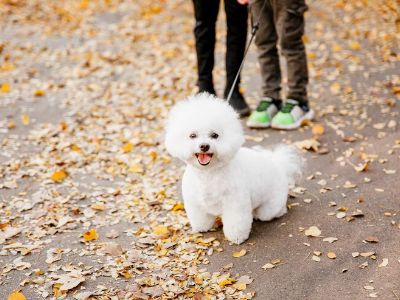
The harness is an extreme yet effective method to make your pup walk. I say extreme because they are tight on dogs and make them uncomfortable at times. But, instead of using a collar harness is a better option because it distributes the pressure evenly. Here are some tips on using a harness to make your pup walk:
- Pick an ideal harness for your furry friend, make sure it goes around their chest and back and also has a clip on the back for attaching a lead.
- Adjust the harness and make sure your puppy is comfortable with the pressure i.e. not too tight or loose. When your puppy wears the harness, reward them with a food treat or toy.
- Use the lead attached to the harness and walk them slowly without forcing them. If they begin to walk, see how many steps they are walking. Encourage this behaviour using a reward.
You can navigate your pup’s movement using the harness. Once they are used to this, you can gradually increase their walking steps and eventually take them outside for a walk.
#5 Command training
You will be surprised that you can use your obedience training and train your pup to follow certain commands to make them walk. Here is how you can achieve that:
- For training your pup to follow commands, you will have to use some treats and toys as positive reinforcements.
- Start with basic commands like “sit” and “stand”. These commands will help initiate movements of their legs. So, when you command them, and they obey, offer them their reward.
- Build on the previous activity and make train them to follow other commands.
- Train them using commands like “come”, “heel”, or any such command indicating action and reward them on obedience.
- You sit in different areas around the house and call them. If they follow your cue, then show positive gestures, for instance, pat their back and give them a small food treat.
So, if your pup follows your command, you won’t have to spend extra time in other training. You can take them on short walks and see whether they resist or not.
Additional Tips On Walking a Puppy Who Refuses To Walk
Before taking your puppy for a longer walk, it’s important to know how far can a puppy walk based on their age.
In the previous section, we saw some basic methods that can help in making a puppy walk, and sometimes it’s possible that none of them would encourage the pup to walk. So, here are some additional tips you can consider trying if those don’t work:
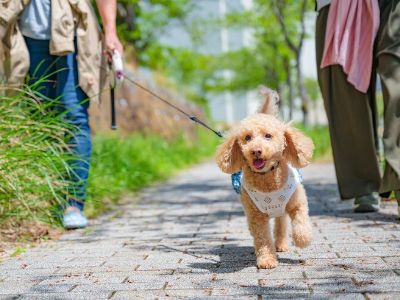
- Take help from a friend or family member
On some occasions, pups show resistance to walking because they are feeling insecure or shy. They are not comfortable around strangers out there in public. So, in such a situation, you can call over your friend or family member.
Make your dog greet them and interact. This will help them lower their guard around strangers. If their behaviour is proper, you can encourage them to walk and see if they follow the cue. Also, the next time you prepare to go for a walk, call the same person and have them walk alongside you.
Once your pup begins to walk like this on a regular, you can try walking with them alone. If they are not resisting you can continue the routine for a longer time. When walking with someone else, make sure you do not exceed the legal limit of dogs one person can walk at once. Check your local regulations on how many dogs can you legally walk at once.
- Change their route
If your pup is refusing to walk it’s a possibility that they are bored of the route you take them or are scared of something that comes along the way. Regardless, you can try and alter the route and see whether they are willing to walk or not.
Remember, when you alter their route, avoid picking ones where there is more sound, excessive smell, or anything which might unsettle your pup. If you take them out at night, having a dog walking torch can make new routes feel safer and more inviting
- Give them a purpose
May seem weird but, this trick can work. Take a small vest or backpack having pockets or pouches in it. Make your pup wear them and put something in them. The weight of the item will indicate to your puppy that there is a task that needs to be performed.
Doing this will give your pup a sense of purpose and encourage them to follow your cue and start walking. The weight in these backpacks or vests must remain lightweight so that they do not get tired quickly and walk longer distances.
Puppy Refuses To Walk – Why?
Till now, I shared some of the tips and tricks for making a puppy walk[1]. But, it’s crucial to understand why they refuse to walk. So, let’s get into the specifics of this aspect:
#1 Health issues
If your puppy is suffering from any health issue or is experiencing pain while walking, it will refuse to walk. They might be having joint pain, infection, a congenital defect, limping issue, panting, diarrhoea, vomiting, panting, or loss of their appetite. So, if you notice any of such signs you must address them instantly, and take them to the vet for treatment.
#2 Fear
Puppies get scared easily. So, if their first walk experience was not good, they often refuse to walk again. Loud noises, strangers, traffic, the other animals or dogs on the street make them nervous. In such situations, you may have seen them bark, growl, or make an attempt to escape.
So, if your pup has had a similar experience, they will associate the bitter experience and will not respond to your call for a walk. In this situation, you need to help your pup overcome their fear. You can try and make them walk through a route which would have minimum noise and fewer people.
#3 Lack of lead training
If you haven’t trained your puppy to walk with lead on, it will resist. This happens because they get scared and feel restrained against the lead. They will try to escape, pull back themselves, or lie down when you use lead on them.
Thus, you must train them to walk with lead-on to avoid such a scenario. Use toys, and food treats, and encourage their positive behaviour while the lead is on. This will make them associate the event with good stuff and the next time you take them to walk on lead they won’t show aggressive behaviour or resist. Start with small walks in familiar terrain and gradually move to different places.
#4 Weather
Sometimes the weather is bad or not safe for pups and they will refuse to walk. As a dog owner, you may also not feel like taking them out for a walk when there is heavy rainfall, snowfall, or extremely hot conditions. So, in this scenario, it’s best not to take them out for a walk.
#5 Exercise
You may be surprised but, if your pup has not recovered from the energy loss after their exercise, they will not walk. Their energy levels are not as high as an adult dog, also they need less exercise in comparison to adult dogs. So, you need to ensure you are not overdoing their exercise and also make sure they get enough rest before you take them out for a walk.
These were some of the prominent reasons why a puppy would refuse to walk. But, that’s not it. There are some other aspects which affect their resistance. Let’s have a peek at them.
Additional reasons why puppy refuses to walk
The reasons mentioned in the previous section are easily noticeable. In this section, I will share some other reasons why your pup is not willing to walk.
- Boredom – following the same routine every day can result in boredom. A pup’s low arousal levels and lack of encouragement can cause them to not walk with you anymore. They might have lost their interest in the same walking routine and thus, it’s crucial to take it up a notch and make them more interesting for your puppy. Try changing the environment, making it challenging, or including some fun stuff.
- Lack of confidence – your puppy may have low self-efficacy or self-esteem and is feeling uncertain or insecure with the notion of walking. They either have less confidence in you or themselves. Hence, you need to gain their trust using positive reinforcements, showing support in their activities, and motivating them. Whatever you do, avoid scolding them because it may make the situation worse.
- Stubbornness – contrary to the lack of confidence, if your pup has high self-control and assertiveness, they will exhibit stubborn behaviour as they prefer their own choices. So, not walking with you may also be a sign indicating that they have different interests or preferences. For such behaviour, you need to proceed with a training regime which will help in controlling this stubbornness and improving their obedience.
- Separation anxiety – when you leave your dog alone in the house, they get attached to the household environment more. So, when you decide to take them out for a walk, they will resist because of their attachment to the house. Also, they fear that you may leave them out and they won’t get to come back home. Hence, you need to make them realise that walking is not a sign of separation or an attempt to take them away from home. You need to reduce their attachment to the house and control their anxiety.
FAQs
How can I make my pups walk more interesting?
If your puppy refuses to walk, you can make it interesting or fun by offering them rewards, and encouragement, altering their route, showing affection, and embracing their company. You can make it fun by including their training exercise in their walking schedule itself. But, make sure you don’t make them overdo it. Pick a nice route if you plan such exercise so, that other people are not at risk.
Which dog breed puppies refuse to go on walks?
Bluffmastiffs, English Bulldogs, and Bichon Frises’ breed puppies may refuse to go out for a walk. This happens because they are lazy in nature, have low energy levels, and have difficulty breathing because of their snouts. This doesn’t imply other breed pups won’t refuse to walk. There are plenty of other factors which can make a pup not go out for a walk with its owner.
When can I take my puppy for a walk if my puppy refuses to walk?
Once you train your pup to follow your command, deal with the underlying issue which makes them refuse to walk, and encourage them, you can take them for a walk. You need to ensure they are confident while going out with you. Make them feel comfortable and motivate them while walking. This will help in building trust and, they won’t resist your command from next time onwards.
How to make a puppy walk schedule for a puppy refusing to walk?
For a pup refusing to walk, making a schedule for walking is a tedious task. You will have to consider factors like age, breed, health, temperament, size, and personality before deciding their walk time. In addition, identifying reasons why there is hesitation to go out on walks is also crucial. Try aiming for 5 minutes per month of age. You can adjust this as per your pup’s energy levels and preferences.
How To Walk a Puppy That Doesn’t Want To Walk – Concluding Remarks
When a puppy refuses to walk, it’s obvious for the owners to feel low or feel bad about themselves. In my experience, they feel this because they think they are lacking in nurturing them. But, in reality, there are many aspects and factors which make a pup refuse to walk with their owners. So, as a dog owner, you must not get discouraged rather address this issue and make efforts to make your pup walk.
You can follow the tips that I have mentioned throughout the article or use your own. If there is no improvement and they are still refusing to walk, you must consult behaviourists and vets to get proper insights and identify the reason behind their resistance.
Lastly, if you manage to make your pup walk using some different trick, share it with me in the comments!
Refernce:
- Cpdt, S. G. M. (2021, April 21). Why does my puppy refuse to go on walks? American Kennel Club.
